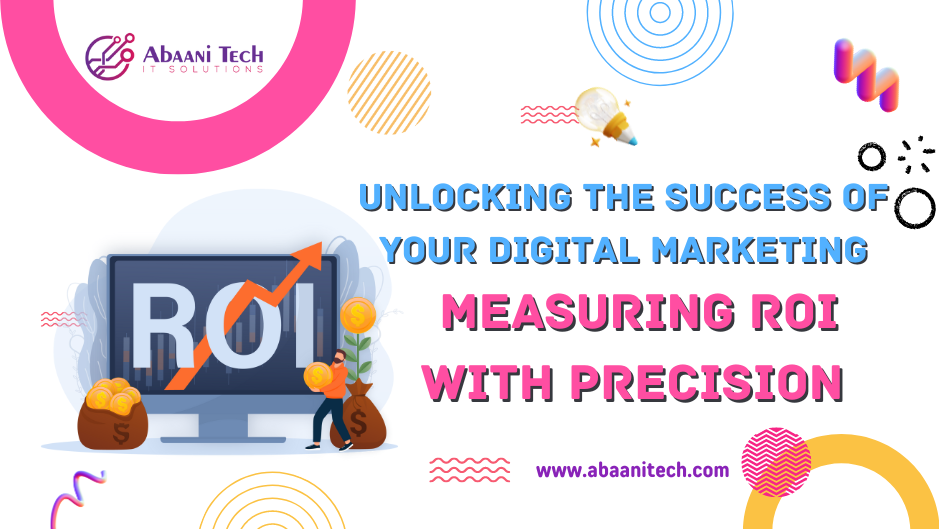Unlocking the Success of Your Digital Marketing: Measuring ROI with Precision


Have you ever wondered if your digital marketing efforts are paying off? Measuring the Return on Investment (ROI) of your digital marketing campaigns is crucial for the success of your business. Whether you’re a seasoned marketer or just starting, understanding the effectiveness of your strategies empowers you to make data-driven decisions, optimize your campaigns, and achieve remarkable results.
In this article, we will delve into practical ways to measure the ROI of your digital marketing efforts and unlock the potential for growth and success.
- Understanding ROI
- Key Performance Indicators (KPIs)
- Setting SMART Goals
- Tracking Website Traffic
- Analyzing Conversion Rates
- Assessing Customer Lifetime Value (CLV)
- Evaluating Cost per Acquisition (CPA)
- Measuring Return on Advertising Spend (ROAS)
- Monitoring Social Media Engagement
- Calculating Email Marketing ROI
- Utilizing UTM Parameters
- Power of Marketing Automation
- Understanding Attribution Models
- Conclusion
- FAQs
Understanding ROI
ROI is a key metric used to assess the profitability of your investments. In digital marketing, it helps you gauge the effectiveness of your campaigns and identify areas for improvement. To calculate ROI, use the following formula:
ROI = (Revenue – Cost) / Cost x 100
This formula enables you to determine the percentage of return on every dollar invested in your marketing efforts.
Key Performance Indicators (KPIs)
KPIs are essential for measuring the success of your digital marketing campaigns. They provide valuable insights into the performance of specific marketing initiatives. Some common KPIs include:
- Click-through Rate (CTR): Measures the percentage of users who clicked on a specific link or ad.
- Conversion Rate: Evaluates the percentage of visitors who completed a desired action, such as making a purchase or filling out a form.
- Bounce Rate: Indicates the percentage of visitors who left your website without interacting further.
- Customer Acquisition Cost (CAC): Calculates the cost required to acquire a new customer.
Setting SMART Goals
Before diving into measuring ROI, establish Specific, Measurable, Achievable, Relevant, and Time-bound (SMART) goals for your digital marketing campaigns. SMART goals provide clarity and help you stay focused on what you want to achieve.
Tracking Website Traffic
Analyzing website traffic is a fundamental step in measuring ROI. Utilize tools like Google Analytics to monitor the number of visitors, pageviews, and the average time spent on your site. By understanding your website’s performance, you can optimize it to enhance user experience and conversion rates.
Analyzing Conversion Rates
Conversion rates play a vital role in determining the effectiveness of your marketing efforts. Analyze the conversion rates of various channels, such as social media, email campaigns, and paid advertising. Identifying high-converting channels can guide your marketing budget allocation.
Assessing Customer Lifetime Value (CLV)
Customer Lifetime Value (CLV) refers to the total revenue generated by a customer throughout their relationship with your business. Understanding CLV helps you focus on retaining loyal customers and tailoring your marketing strategies accordingly.
Evaluating Cost per Acquisition (CPA)
CPA measures the cost of acquiring a customer through specific marketing channels. It aids in identifying cost-effective channels and optimizing your budget allocation for better returns.
Measuring Return on Advertising Spend (ROAS)
ROAS evaluates the revenue generated from your advertising investments. To calculate ROAS, divide the revenue generated from ads by the cost of those ads. A ROAS greater than 1 indicates a positive return on your ad spend.
Monitoring Social Media Engagement
Social media engagement is a valuable metric to gauge how well your content resonates with your audience. Track metrics like likes, shares, comments, and click-throughs to assess engagement levels and refine your social media strategies.
Calculating Email Marketing ROI
Email marketing remains one of the most effective marketing channels. Measure the ROI of your email campaigns by tracking open rates, click-through rates, and conversion rates. Personalize your emails to enhance engagement and maximize ROI.
Utilizing UTM Parameters
UTM parameters are tags added to your URLs to track the source, medium, and campaign name of incoming traffic. By using UTM parameters, you can identify the most effective marketing channels and campaigns.
Power of Marketing Automation
Marketing automation streamlines repetitive tasks, allowing you to focus on strategy and creativity. It enhances efficiency, reduces human error, and helps you deliver personalized experiences to your audience.
Understanding Attribution Models
Attribution models attribute conversions to the appropriate marketing touchpoints. Various models, such as first-click, last-click, and multi-touch, offer different perspectives on how customers interact with your marketing efforts. Understanding these models helps you make informed decisions based on data.
Conclusion
Measuring the ROI of your digital marketing efforts is a crucial aspect of running a successful online business. By understanding key metrics, setting SMART goals, and utilizing powerful tools like Google Analytics and marketing automation, you can optimize your campaigns for maximum returns. Remember, data-driven decision-making is the key to unlocking the full potential of your digital marketing endeavors.
FAQs
- How can I calculate the ROI of my digital marketing campaigns?
To calculate ROI, use the formula: (Revenue – Cost) / Cost x 100. This gives you the percentage of return on your marketing investment.
- What are KPIs, and why are they important?
Key Performance Indicators (KPIs) are metrics used to measure the success of specific marketing initiatives. They provide insights into your campaign’s performance and guide decision-making.
- How do I track website traffic effectively?
Utilize tools like Google Analytics to monitor the number of visitors, pageviews, and average time spent on your site.
- What is Customer Lifetime Value (CLV), and how can it benefit my business?
Customer Lifetime Value (CLV) is the total revenue generated by a customer over their relationship with your business. Understanding CLV helps you focus on customer retention and loyalty.
- What is the significance of ROAS in digital advertising?
Return on Advertising Spend (ROAS) measures the revenue generated from your advertising investments. A ROAS greater than 1 indicates a positive return on ad spend






